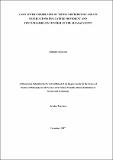| dc.description.abstract | Anthropogenic activities changes ecosystem structure, and alter the vital rates of vectors, host-vector interaction and consequently disease transmission dynamics across the landscape. This research examined the participatory epidemiology to elicit Maasai pastoralist knowledge on land use changes, cattle grazing patterns and trypanosomiasis control. Furthermore, abundance and infection rates were determined in relation to age of tsetse flies, habitat types, host presence and predicted potential spatial distribution patterns in the Maasai Steppe of northern Tanzania. Tsetse abundance was obtained through geo-referenced straps, host counts around trap sites, between July 2014 and November 2015 in selected habitats across four villages: Emboreet, Loiborsireet, Kimotorok and Oltukai adjacent to protected areas. PCR identification of trypanosome species performed an to establish the infection rates. Extraction of monitored Normalized Difference Vegetation Index (NDVI) data derived from Moderate Resolution Imaging Spectrometer (MODIS) were performed asses vegetation cover changes. Presence only niche modelling approach used to predict spatial distribution of tsetse species through integration of heterogeneous biophysical factors across the entire landscape with tsetse presence data. Our findings show the variation of tsetse fly species abundance and infection rates among habitats in surveyed villages in relation to NDVI and host abundance. Results show higher tsetse fly abundance in Acacia-swampy ecotone, open woodland and riverine habitats. Tsetse species abundance was inconsistent among habitats in different villages. Emboreet was highly infested with Glossina swynnertoni (68%) in ecotone and swampy habitats followed by G. morsitans (28%) and G. pallidipes (4%) in riverine habitat. In the remaining villages, the dominant tsetse fly species by 95% was G. pallidipes in all habitats. Trypanosoma vivax was the most prevalent species in all infected flies (95%) with few observations of co-infections (with T. congolense or T. brucei). The relationship of tsetse with abundance of wildlife and livestock was more complex, as we found positive and negative associations depending on the host and fly species. Furthermore, niche modelling of tsetse species provides the hotspots for tsetse infestations and infections and hence plan for cost effective eco-health intervention approaches to increase the resilience of pastoral communities against Trypanosomiasis. | en_US |

